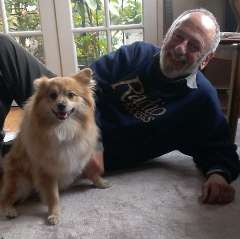With a potent cast and a superb platoon of dancers featuring dazzling talent throughout its ranks, LA Opera’s new co-production of Gluck’s Orphée et Eurydice with the Lyric Opera of Chicago and Staatsoper Hamburg presented a surrealistic twist on the old myth to a glamorous LA crowd. Using the 1774 version, John Neumeier unleashed his choreographer’s inner self and created a modern ballet/opera in which dance took over the stage and most of the opera. In doing so the leisure and grace with which the dancers visually expressed the music’s emotional basis expanded the score's classical simplicity beyond its purely musical means with extraordinary, if occasionally mind-numbing means. Eventually all coalesced into a intoxicating dream in which the stage was almost entirely inhabited by the dancers and the chorus, with three large set elements whose mirrors played a highly symbolic role in two constantly changing modes, transparent and reflective.
The movement and what there was of dramatic development flowed naturally from Neumeier’s conceit of Orphée as a choreographer (and Euridice a temperamental prima ballerina) rehearsing a new ballet appropriately called The Isle of the Dead, inspired by the same Arnold Böcklin whose painting inspired Rachmaninov’s lugubrious symphonic poem of the same name.
Aside from occasional forays where they interact with the forces on stage the three singers do most of their work on a small patch of grass at the side of the stage. Long, lean, and slightly awkward Maxim Mironov had the feel of a Giacometti figurine, ideally suited to wander through realms of dreams, and his voice even at its most beautiful and tender seemed charged with deeper emotional concerns. Lisette Oropesa’s Eurydice was exquisite and Liv Redpath’s beautifully sung Amor was charming and resourceful.
Overall it was both a sweetly innocent and highly sophisticated take on the opera; it dared to retain the pathos of the iconic unhappy ending by keeping Eurydice’s physical presence even after she had returned only a shadow, and when it was in these quieter moments the performance felt closest to the opera’s musical core. The orchestra got the nobler parts right but didn’t quite explode at the opening of the Overture or burn during the “Dance of the Furies”. They made unaccountably little of the woodwind billings and cooings in Mironov’s splendid “Che pur ciel”, and they did not effectively exploit the echo effects from the English horn in his “Chiamo il mio ben cosi”.
Otherwise, the orchestra played all the musical numbers alertly and often sumptuously in the Romantic manner. In his program note James Conlon singles out Berlioz and Wagner for the influence Gluck had on them but neglected to mention Mozart, on whom Gluck’s influence may have been the most profound. And while Gluck’s Orphée seemed to have triumphed at its opening, there are other ways of playing the that LA Opera might consider – namely the period instrument way. It might have made the musical elements more effective, not to mention that nine of the last ten recordings feature period musicians.




